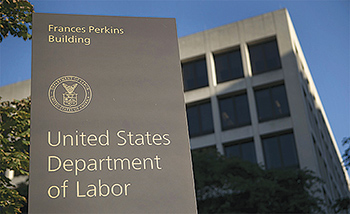Biden moves to ax Trump rule on financial oversight of unions

The U.S. Department of Labor has proposed rescinding a Trump-era rule that subjected union funds to stricter transparency requirements, a decision that the agency argued won’t hinder the federal government’s ability to deter corruption in Organized Labor.
The department’s Office of Labor-Management Standards (OLMS) published a proposal last month to scrap the 2020 rule, which had required unions with at least $250,000 in annual receipts to disclose information about their credit unions, strike funds, apprenticeship programs, and any other trust they maintain.
Under Director Jeffrey Freund, one of the Biden administration’s earliest Labor appointees, the agency halted enforcement of the rule in March, before unions faced a deadline to start submitting the new “Form T-1” disclosures the regulation had mandated.
The 2020 rule is “quite duplicative” of unions’ existing disclosure mandates, Freund said in an interiew with Bloomberg Law. He added that there’s “a serious question about” whether the agency has statutory authority to demand these new forms. The agency will now consider that issue as it solicits public comment for the next 60 days to inform a final decision on withdrawing the rule.
PRIOR REQUIREMENTS STILL IN PLACE
The agency will continue to enforce unions’ longstanding annual obligations to file detailed financial information — including receipts on funds diverted to trusts — in so-called LM-2 reports, which are required for all unions with annual receipts exceeding $250,000, Freund said.
The move to erase the Trump rule, though it had been expected, will likely provide fresh ammunition to business lobbyists and critics of Organized Labor who contend the Trump regulation was needed to curb the type of corruption that fueled the embezzlement scandal at the United Auto Workers, which resulted in multiple convictions and guilty pleas and a federal monitor being appointed to oversee the union for six years.
But Freund, formerly a longtime attorney representing unions at the firm Bredhoff & Kaiser, said the agency is still vigorously enforcing existing financial disclosure requirements, and there are already effective government controls to combat union malfeasance.
Government agencies, including OLMS, uncovered the UAW-Chrysler scheme, investigated it, and won multiple convictions — all before the T-1 rule was issued, Freund said.
‘HEAD-SCRATCHER’
“There’s a whole regime of reporting requirements that are there that capture much, if not all, of the data that T-1 was intended to capture,” Freund said, noting Form 5500s, which DOL’s Employee Benefits Security Administration collects from union benefit trusts, and the 990 forms that some union subsidiary organizations must file with the Internal Revenue Service.
“Why anyone would think that folks who fraudulently filed 990s and 5500s would then in turn honestly file T-1s is a head-scratcher to me,” he added.
TRIO OF MEASURES TARGETING UNIONS
The T-1 rule was part of a trio of late-term measures the Trump administration pursued in the area of union oversight. The other two were never finalized, likely meaning they were dead on arrival once Biden took office.
One proposal had sought to make public-sector mid-level union chapters subject to the same level of financial oversight as private-sector unions.
The other sought to increase the amount of financial information the largest unions are required to submit to the DOL, with a particular focus on unions that take in $8 million or more a year. That rule had called for more detailed reporting of separate strike funds, investment and asset sales, lobbying disclosures, and payments made to a single officer from more than one union.
(Information from Bloomberg Law)



Leave a Reply